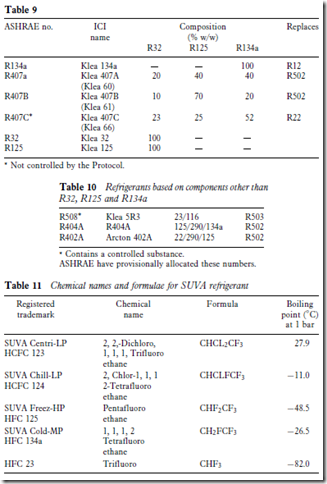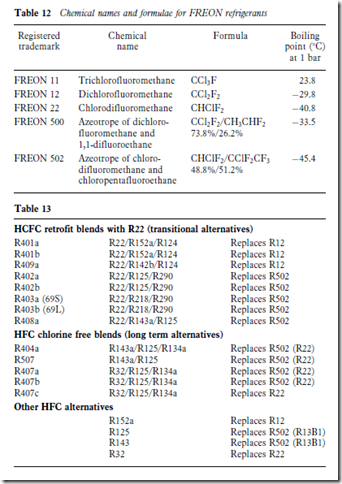For the long term replacement of CFCs and HCFCs, various manufacturers have developed products designed to meet the requirements of the industry.
In October 1990 ICI was the first company to introduce HFC 134a, an alternative to CFCs used in refrigeration and air conditioning. Since then other refrigerants have been introduced and marketed by ICI as Klea 134a.
Klea 32, the second in the Klea range, went into production in 1992. As these refrigerants were successful a number of blends were introduced to the range including Klea Blend 60 and Klea Blend 66, ozone benign refrigerants based on Klea 32 and Klea 134a. These are the alternatives to HCFCs. Each of these is non-toxic, non-flammable and has a good heat transfer property. All have undergone extensive trials, both in laboratory and systems in the field.
These refrigerants have a zero ODP and are currently not subject to regu- lation. European Union Regulation member states agreed to cease producing CFCs with effect from 1 January 1995. Regulations regarding the HCFC products meant that they would eventually be phased out although it was understood that interim products were necessary to assist the refrigeration industry during transition away from CFC refrigerants.
Tables 9 to 12 list the replacement and new refrigerants as long term CFC and HCFC replacements together with interim products.
There exists some confusion with regard to CFCs, HFCs and HCFCs; also refrigerant blends appear to come under various categories. In some quarters it is believed that CFCs are ‘banned’. This is not exactly correct; they are still obtainable for those willing to pay the price and are still widely used. The manufacture of CFCs has now ceased.
There are a great number of refrigeration systems charged with CFCs oper- ating nationwide and users are unlikely to go to the expense of changing the refrigerant charge until a major breakdown occurs.
To summarize: by the year 2000 or possibly earlier R22 will be phased out, meanwhile the refrigerants listed in Table 13 may be used.
evaporation and condensing processes. The phase change occurs with zeotropic refrigerants in a ‘gliding’ form over a particular temperature range. This temperature glide can vary and is mainly dependent upon the percentage and boiling points of the individual components of its composition. When a blend has less than 5K glide it is sometimes referred to as ‘near azeotropic’ or ‘semi-azeotropic’, R404 being an example of this.

